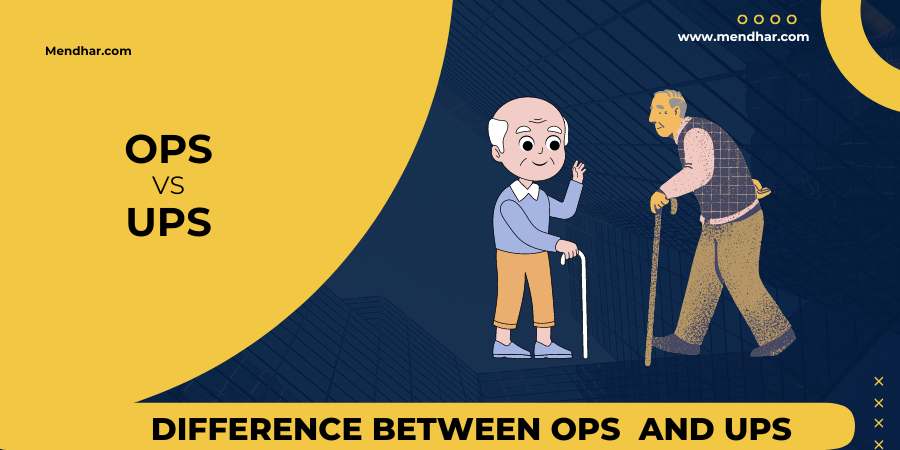Table of Contents
ToggleUnderstanding the Difference Between OPS and UPS

The debate between OPS and UPS around the continues to be a significant topic of discussion among government employees. The introduction of UPS was intended to address some of the sustainability concerns associated with OPS while also providing fair benefits to employees. Understanding the details of these schemes and how they compare can provide insight into why this debate remains relevant.
What is OPS (Old Pension Scheme)?
OPS is a traditional pension scheme that was available to government employees before being replaced by newer systems. Under OPS, employees received a defined pension based on their last drawn salary, and this amount was guaranteed by the government. The pension amount was generally 50% of the employee’s last basic salary and would continue throughout the retiree’s lifetime, with regular adjustments for inflation.
Key Features of OPS:
- Guaranteed Pension: The pension amount is fixed at 50% of the last drawn salary, ensuring a stable income after retirement.
- Inflation-Linked: The pension increases over time to keep pace with inflation, providing retirees with financial security even as costs rise.
- Family Pension: In the event of the pensioner’s death, their spouse or dependents would continue to receive a family pension.
- Government-Funded: The pension is entirely funded by the government, with no contribution required from the employee during their working years.
What is UPS (Unified Pension Scheme)?
The Unified Pension Scheme (UPS) is a more recent system designed to replace both OPS and other schemes like the New Pension Scheme (NPS). It is intended to be a hybrid of the best elements of both the defined benefit and defined contribution models. Under UPS, both the government and the employee contribute to a pension fund, but it also includes features that make it more secure than fully market-dependent schemes.
Key Features of UPS:
- Contributory System: Employees contribute a percentage of their salary to the pension fund, matched or exceeded by contributions from the government.
- Partial Guaranteed Pension: Like OPS, UPS offers a guaranteed minimum pension amount, ensuring some level of financial stability. This pension is based on a percentage of the employee’s last salary.
- Market-Linked Returns: A portion of the employee’s pension is invested in a managed fund, offering the potential for higher returns depending on the fund’s performance.
- Family Pension: In case of death, the pensioner’s family can receive a part of the accumulated pension or an adjusted amount, similar to OPS.
- Sustainable Model: Unlike OPS, which places the entire burden on the government, UPS is designed to be financially sustainable, with contributions from both parties and investments in the market to grow the pension fund.

Key Differences Between OPS and UPS
| Feature | Old Pension Scheme (OPS) | Unified Pension Scheme (UPS) |
|---|---|---|
| Type of Scheme | Defined Benefit Scheme | Hybrid Scheme (combines defined benefit and contribution) |
| Pension Amount | 50% of the last drawn salary | Partially guaranteed, with potential market-linked returns |
| Contributions | No contribution from the employee | Employee and government both contribute |
| Inflation Adjustment | Yes, pension increases with inflation | Partial adjustment based on guaranteed portion |
| Risk | No risk, pension is fully guaranteed | Some risk due to market-linked portion |
| Pension for Family | Yes, family pension available | Yes, family pension available |
| Government Liability | Fully on the government | Shared between employee, government, and market |
| Withdrawal | No withdrawal before retirement | Limited withdrawal options, based on contributions |
| Taxation | Pension is taxable | Pension is taxable, but some contributions may be tax-exempt |
Example: Faiz’s Pension Under OPS vs. UPS
Let’s take the example of Faiz, a government employee who has worked for 35 years with a last drawn basic salary of ₹60,000. Below is a comparison of his retirement benefits under OPS and UPS.
Faiz’s Pension Under OPS:
| Details | Value |
|---|---|
| Last Drawn Salary (Basic) | ₹60,000 |
| Pension Percentage | 50% |
| Monthly Pension | ₹30,000 |
| Annual Pension | ₹3,60,000 |
| Inflation Adjustment | Yes, with annual increases |
Faiz’s Pension Under UPS:
| Details | Value |
|---|---|
| Employee Contribution (10% of salary) | ₹6,000/month |
| Employer Contribution (14% of salary) | ₹8,400/month |
| Total Monthly Contribution | ₹14,400 |
| Accumulated Pension Fund (after 35 years, assuming 8% return) | ₹1.36 crore |
| Guaranteed Pension (30% of last salary) | ₹18,000/month |
| Market-Linked Portion (based on returns) | ₹12,000/month (approx.) |
| Total Monthly Pension | ₹30,000 (approx.) |
| Annual Pension | ₹3,60,000 |
| Inflation Adjustment (only on guaranteed portion) | Partial |
Key Observations from the Example:
- Guaranteed Pension: In OPS, Faiz receives ₹30,000 per month, with adjustments for inflation. Under UPS, Faiz receives a guaranteed minimum of ₹18,000 from his last drawn salary, with an additional amount coming from his market-linked investment, totaling approximately ₹30,000 per month.
- Contributions: Under OPS, Faiz did not contribute to his pension fund. However, under UPS, both Faiz and the government contributed to his pension fund during his employment.
- Risk and Return: In OPS, Faiz’s pension is risk-free and guaranteed. In UPS, part of his pension is guaranteed, but the rest depends on the market’s performance, introducing some level of risk.
- Sustainability: OPS places the entire financial responsibility on the government, while UPS is designed to be more sustainable, sharing the burden between Faiz, the government, and the market.
Benefits and Drawbacks of OPS
Benefits:
- Guaranteed Income: Employees receive a stable, guaranteed pension amount that is not subject to market risk.
- Inflation Protection: Pension amounts increase with inflation, helping retirees maintain their purchasing power.
- Security for Family: Family members are eligible for a pension in case of the retiree’s death.
Drawbacks:
- Government Burden: The entire financial burden falls on the government, which may not be sustainable in the long term as more people retire.
- No Flexibility: Employees cannot access their pension savings before retirement, nor do they have control over how the funds are managed.
Benefits and Drawbacks of UPS
Benefits:
- Sustainability: UPS is more financially sustainable as it shares the responsibility between the employee, government, and market investments.
- Flexibility: Employees have more control over their pension contributions and can choose how much to invest in the market.
- Partial Guarantee: Unlike fully market-linked schemes, UPS offers a guaranteed minimum pension, providing some financial security.
Drawbacks:
- Market Risk: Part of the pension is linked to market performance, which introduces some risk.
- No Full Inflation Adjustment: While the guaranteed portion of the pension may be adjusted for inflation, the market-linked part may not increase with inflation.
Conclusion:
The choice between OPS and UPS depends on individual priorities, such as financial security, risk tolerance, and the desire for flexibility. OPS offers a guaranteed pension with complete security but places a significant financial burden on the government. UPS, on the other hand, offers a more sustainable model by combining guaranteed pension benefits with market-linked returns, though it introduces some level of risk.
For employees like Faiz, the decision between OPS and UPS involves weighing the certainty of a stable, guaranteed income against the potential for higher returns and flexibility with UPS. While UPS may be better suited for the long-term sustainability of pension systems, OPS remains attractive for those seeking predictable and guaranteed income during retirement.
In the end, the debate between OPS and UPS is likely to continue, as employees and policymakers weigh the benefits of financial security against the need for a sustainable pension system that can serve future generations.


Pingback: NMOPS Takes a Stand Against NPS and UPS -